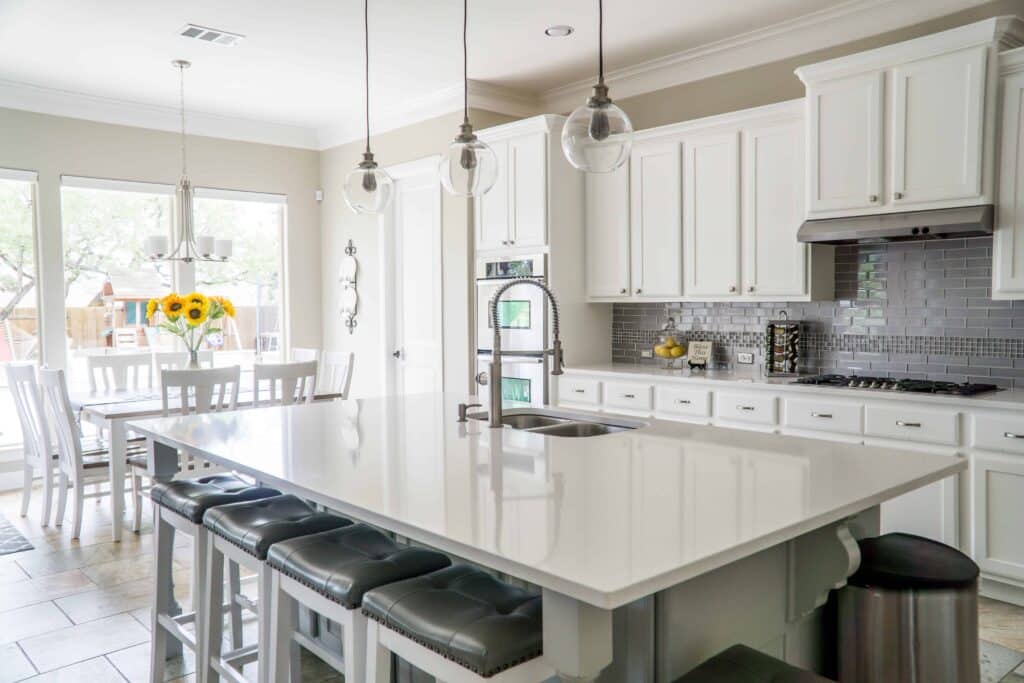
Crown molding adds an elegant finishing touch to cabinets, transforming them from functional storage spaces into stunning pieces of furniture that elevate the overall aesthetics of a room. Beyond its decorative appeal, crown molding also serves a practical purpose by concealing gaps and inconsistencies between cabinets and ceilings. Learning how to install crown molding is a valuable skill if you want to enhance the visual appeal of your kitchen, bathroom, or any other space with cabinets. This comprehensive guide will walk you through the step-by-step process of installing crown molding on cabinets, helping you achieve a professional and polished look that will leave a lasting impression.
How To Install Crown Molding On Cabinets
Installing crown molding on cabinets is a project that can enhance the overall appearance of your cabinets and add a touch of sophistication to your space. Crown molding is a decorative trim typically installed at the top of cabinets to conceal the gap between the cabinet and the ceiling. Here’s a step-by-step guide on how to do it:
Gather Your Materials:
Before you begin, ensure you have all the necessary materials and tools ready. You’ll need crown molding, measuring tape, a miter saw, a coping saw, wood glue, a nail gun, brad nails, sandpaper, safety gear (such as goggles and gloves), a level, and a caulking gun.
Measure and Mark:
Start by measuring the length of the cabinets where you intend to install the crown molding.
Additionally, mark the desired height for the crown molding along the cabinets. Using a level to ensure that your marks are straight and even is crucial, as this will result in a polished final appearance.
Cutting the Crown Molding:
Crown molding installation often involves making miter cuts for both inside and outside corners. For inside corners, you’ll need to cut one piece of crown molding with an inward angle, while outside corners require an outward angle. A miter saw is the ideal tool for making these cuts. To achieve precise fits at corners, use a coping saw to carefully cope with the ends of the molding.
Attaching the Crown Molding:
Begin by applying wood glue to the back of the crown molding piece. Position it against the cabinet, ensuring it aligns with your marked height. Secure the molding in place using a nail gun and brad nails. Repeat this process for each molding section, creating tight joints at the corners.
Filling and Sanding:
To achieve a flawless finish, fill any gaps, nail holes, or imperfections in the molding with wood filler. Once the filler has dried, use sandpaper to smooth the surface of the molding. This step is essential for achieving a polished and professional appearance.
Finishing Touches:
Apply paint or finish to the crown molding to match your cabinets or the overall room decor. This step enhances the aesthetic appeal and provides a protective layer for the molding.
Additionally, consider using caulk to seal seams, ensuring a seamless and cohesive look.
Clean Up:
After completing the installation, thoroughly clean your workspace. Remove any excess glue, paint, or debris to leave your cabinets looking pristine.
By following these detailed steps, you can successfully install crown molding on your cabinets, resulting in a refined and elegant look that will undoubtedly enhance the visual appeal of your space. Remember that attention to detail and patience are crucial to achieving the best results in this home improvement project.
Preparing For Installation
Preparing for installing crown molding on cabinets is an essential precursor to achieving a polished and professional finish. This initial phase involves ensuring safety, gathering the necessary materials, and making accurate measurements and markings.
First and foremost, prioritize safety. Equip yourself with appropriate safety gear, such as safety goggles and gloves, to protect against potential hazards during installation. Ensure the workspace is secure, free from obstacles, and well-lit, minimizing the risk of accidents.
Next, gather all the required materials and tools for the project. These include crown molding, measuring tape for precise measurements, a miter saw for accurate angle cuts, a coping saw to cope the ends of the molding for tight fits, wood glue for a strong bond, a nail gun with brad nails to secure the molding, and various grits of sandpaper for a smooth finish.
Lastly, meticulous measuring and marking are vital. Measure the length of the cabinets where the crown molding will be installed, and mark the desired height for the molding. It is essential to ensure that these marks are level and accurate, as they dictate the alignment and aesthetics of the final installation.
In summary, proper preparation is fundamental to a successful crown molding installation on cabinets. It ensures safety and sets the stage for precision and a visually appealing result. Taking the time to prepare adequately will pay off in the quality and professionalism of the finished project.
Tips And Troubleshooting
Tips and troubleshooting are valuable aspects of any crown molding installation project. Here, we’ll provide practical tips and solutions to common issues that may arise during installation.
Tips
- Accurate Measurements: Accurate measurements are the foundation of a successful crown molding installation. Use a reliable measuring tape and take your time when measuring the length of your cabinets. Double-check your measurements to ensure they are precise. Even small discrepancies can result in poorly fitting crown molding.
- Use Templates: Creating templates for your cabinet corners can be time-saving and error-reducing. Cut small pieces of molding to fit the corners exactly as needed, and use these templates as guides when making miter cuts. This minimizes the chances of making incorrect cuts on your actual molding pieces.
- Practice Miter Cuts: If you’re new to using a miter saw, practice making miter cuts on scrap pieces of molding before tackling your project. Understanding how the saw works and getting a feel for the angles will help you achieve clean and precise cuts when working on your cabinets.
- Secure the Molding: To ensure a secure bond between the crown molding and cabinets, it’s crucial to use wood glue. Apply a thin, even layer of wood glue to the back of the molding before attaching it to the cabinets. Use a nail gun with brad nails to further secure the molding while the glue dries. This combination of glue and nails provides a sturdy and durable attachment.
- Coping Inside Corners: Coping is a technique used to achieve a precise fit inside corners. Take your time when coping with the ends of the molding, as this step ensures that the joint fits snugly and results in a seamless appearance. A well-coped joint eliminates the need for filler and creates a professional finish.
- Sanding and Smoothing: After installing the crown molding, it’s important to sand the surfaces to remove imperfections and achieve a smooth finish. Use progressively finer grits of sandpaper to ensure a polished look. Sanding also helps prepare the surface for painting or finishing, ensuring an even application.
Troubleshooting
- Uneven Cabinet Tops: If your cabinets have uneven tops, you may encounter challenges when installing crown molding. To address this issue, you can use thin wooden shims. Place the shims strategically between the cabinets and the molding to make necessary adjustments and ensure a level installation. This technique can compensate for unevenness and create a seamless transition.
- Gaps and Uneven Joints: Occasionally, you may encounter gaps or uneven joints between the crown molding and cabinets. To resolve this, use wood filler to fill these gaps or imperfections. Once the filler has dried, sand the filled areas to create a smooth and level surface. This process ensures your molding appears seamless and professional after painting or finishing.
- Mismatched Joints: In some cases, mitered joints may not align perfectly due to variations in cabinet angles or wall imperfections. To address this, you can use color-matched wood putty or filler to conceal discrepancies. Carefully apply the putty to the joints, and once it dries, sand it down to create a uniform appearance. This technique helps mask any imperfections in the joints.
- Painting Imperfections: You may notice imperfections such as brush marks or uneven areas after painting the crown molding. To remedy this, lightly sand the affected areas with fine-grit sandpaper to smooth the surface. Afterward, apply an additional coat of paint to achieve a smoother and more polished finish.
- Caulking Issues: If the caulk seams between the molding and cabinets appear uneven or messy, use a caulk smoothing tool or a damp cloth to achieve a clean and professional-looking line. Run the smoothing tool or cloth along the caulk seam, removing excess caulk and creating a smooth, consistent finish. Properly applied caulk improves aesthetics and provides a seal to prevent moisture and debris from entering gaps.
Incorporating these detailed tips and troubleshooting solutions into your crown molding installation project will help you address common challenges and achieve a flawless and visually stunning result. Crown molding installation, when done with patience and attention to detail, can elevate the overall appearance of your cabinets and the room they inhabit.
Bottom Line
Incorporating crown molding into your cabinet installation project can make a difference in your space’s overall appearance and ambiance. By following the steps outlined in this guide, you can achieve a seamless, sophisticated finish that not only conceals imperfections but also adds a touch of timeless elegance to your cabinets. Whether you’re a seasoned DIY enthusiast or a novice, installing crown molding on cabinets is an attainable and rewarding project that can significantly enhance the visual appeal of your home. So, don’t hesitate to take on this transformative task and enjoy the striking results it brings to your living spaces.
FAQ’s
Q. How do I determine the correct angle for miter cuts on inside and outside corners?
The angle for miter cuts depends on the corner and cabinet dimensions. You can use a miter saw’s angle guide or calculate the angles manually. Some miter saws also have presets for joint angles.
Q. Can I install crown molding on cabinets with uneven tops?
Yes, you can install crown molding on cabinets with uneven tops. Shimming is a common technique to make necessary adjustments and achieve a level installation. Thin wooden shims can be strategically placed to compensate for unevenness.
Q. What if my cabinet tops have decorative trim that interferes with crown molding installation?
If your cabinets have existing decorative trim at the top that interferes with crown molding, you may need to remove or modify the existing trim. This will create a flat surface for the crown molding to flush against the cabinet.








